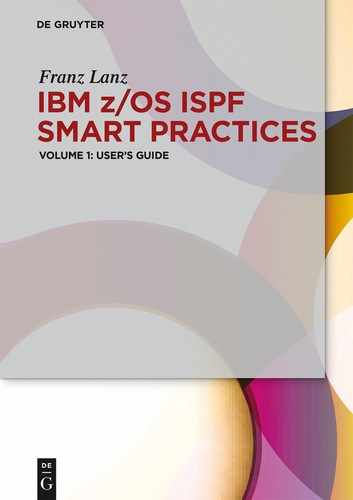Contents
Preface
1 Introduction
1.1 Readers previous knowledge of ISPF
1.2 Using this book
1.3 Screens, source codes, JCL and other displays
1.4 Labeling of important tips
1.5 Citations from other publications
1.6 IBM glossary
1.7 z/OS basic information
1.8 ISPF reference books
1.8.1 ISPF books for ISPF users
1.8.2 ISPF books for ISPF application programmers
1.9 TSO reference books
1.10The ISPF services
1.11Working with ISPF
1.12ISPF interaction
1.13The 3270 screen
1.13.1 3270 screen layout
1.13.2 The full screen technology
1.14 The ISPF online help facility
1.14.1 Call the online help facility
1.14.2 Overview of all commands and functions of ISPF
1.14.3 Description of the DSLIST command
1.15 ISPF sub-systems
1.15.1 SDSF – System Display and Search Facility
1.15.2 IBM Data Set Commander for z/OS
1.15.3 File Manager for z/OS
1.15.4 MVS/QuickRef
1.16 Information sources
2 Technical basics
2.1 Data sets
2.1.1 Allocation of data sets
2.1.2 Naming conventions for data set names
2.1.3 The relevance of qualifiers
2.1.4 Data set types
2.1.5 Other data set types
2.1.6 Concatenated data sets basics
2.1.7 Partitioned concatenated data sets
2.1.8 Sequential concatenated data sets
2.1.9 Abbreviations concerning data sets
3 The TSO/ISPF logon process
3.1 The logon procedure
3.2 TSO start and the user logon process in detail
3.3 ISPF start
3.3.1 Necessary ISPF libraries
3.3.2 Display currently existing library structures
3.3.3 ISPF table service data sets
3.3.4 The user profile library ISPPROF
3.3.5 Contents of ISPF profile library
3.3.6 The ISPF start command
3.3.7 The initial logon procedure XYZLOGON
3.3.8 Rules how a logon procedure may end
3.3.9 The private logon procedure SLOGON
3.3.10 Example of a LOGON procedure
3.4 The SLOGON procedure of the SMART ISPF utilities
3.4.1 Install the SLOGON procedure
4 Customize ISPF
4.1 Available 3270 screen formats
4.2 ISPF options setting
4.3 The ISPF settings panel (Selection 0)
4.4 Panels and their handling
4.5 The structure of ISPF panels
4.5.1 Using HELP panels
4.6 The primary option menu
4.7 Screen splitting
4.7.1 Essential rules and tips for split screen
4.7.2 Direct activation of an ISPF logical screen
4.7.3 Example, with eight logical screens of ISPF
4.8 The program function keys of ISPF
4.8.1 Optimize PF key settings
4.8.2 Switching on the PF key setting display
4.8.3 Utilize KEYLISTs for PF keys
4.8.4 Display the PF key assignment in a KEYLIST
4.8.5 PF keys use without using KEYLIST
5 ISPF command tables
5.1 Execute programs in a TSOP/ISPF environment
5.1.1 Online execution
5.1.2 Batch execution
5.2 Introduction to the ISPF command technology
5.2.1 The member ISPCONF
5.2.2 Datasets for command tables
5.2.3 Creating your own ISPF commands
5.3 Program SICMD
5.3.1 Edit ISPF commands using SICMD
5.3.2 Display the list of all standard ISPF commands
5.3.3 Define the call of SICMD as command
5.3.4 Generating a list of commands
6 DSLIST – Data set lists
6.1 The DSLIST panel
6.2 The possibilities of the action bar for DSLISTs
6.3 The DSLIST panel fields
6.4 DSLIST panel processing
6.4.1 The DSLIST primary commands
6.4.2 The commands MEMBER and SRCHFOR
6.4.3 DSLIST line commands
6.4.4 DSLIST settings
6.4.5 Examples of the data set list settings
6.5 Personal data set lists
6.5.1 Creating personal data set lists
6.5.2 Call DSLISTs
6.6 Entering the DSLIST command with the name of a DSLIST
6.6.1 Entering the DSLIST command without parameters
6.6.2 Using the volume serial field
6.7 DSLIST optimal use with command tables
6.7.1 Organization and naming conventions
6.7.2 Call DSLISTs using the ISPF command table
7 The Object/Action Workplace
7.1 The ISPF workplace panel
7.1.1 Calling the workplace via the command table
7.1.2 Operation of the workplace panel
7.1.3 Action commands in the workplace panel
7.2 Examples of workplace operation
8 The ISPF editor
8.1 Table of EDIT primary commands
8.2 Table of EDIT line commands
8.3 Displaying and maintaining an edit profile
8.3.1 Setting EDIT options with EDSET/EDITSET
8.3.2 EDIT profile settings and their use
8.4 Colored code for EDIT and VIEW
8.4.1 Colored code - what is it?
8.4.2 Setting the colored code
8.4.3 Uniform last level qualifier
8.5 Edit recovery
8.6 The UNDO function
8.7 Turn the UNDO function on and off
8.8 FIND and CHANGE
8.8.1 Definition of search operands
8.8.2 Definition of simple search texts
8.8.3 Definition of special search texts
8.9 Exclude
8.10 SHIFT and OVERLAY
8.10.1 Example one for using OVERLAY
8.10.2 Example two for using OVERLAY
8.11 CUT and PASTE
8.11.1 Data transport via the clipboard of the PC system
8.11.2 Data transport via the ISPF clipboard
9 Utilities for allocated data sets
9.1 DDLIST – Description and call
9.2 DDLIST operation
9.3 Find a member
9.4 Free a data set allocation
9.5 Warning when inconsistent data set structures exist
9.6 The display options SHORT and LONG
9.7 Display system library chains
9.7.1 Display of parmlib member ALLOCxx
9.7.2 Display the LINKLIST chain
9.7.3 Browsing storage and loaded modules
10 Secret Programs
10.1The TSO command CONCATD
10.2Program ISRDSLST
10.3The TASID program
11 The SMART ISPF utilities
11.1 Naming conventions
11.2 The dynamic panel concept
11.3 List of programs
11.4 Program descriptions
11.4.1 Edit macro
11.4.2 Edit macro #ALTXT
11.4.3 Edit macro #EDMEM
11.4.4 Edit macro #IMACROA
11.4.5 Edit macro #IMACRO1
11.4.6 Edit macro #IMACRO2
11.4.7 Edit macro #ISPFB
11.4.8 Edit macro #LCH
11.4.9 Edit macro #SPLJ
11.4.10Edit macro #SSS
11.4.11Edit macro #SSSCH
11.4.12Edit macro #SU
11.4.13Edit macro #TSOB
11.4.14Edit macro #VERASE
11.4.15Program SCURSOR
11.4.16Program SDOC
11.4.17Program SLE
11.4.18Data member SLOGDSN
11.4.19Program SLOGON
11.4.20Program SPROFEDT
11.4.21ISPF variables load member SPROFVAR
11.4.22Program SSC
11.4.23Program SSS
11.5 Installation of SMART ISPF utilities
11.5.1 Download and unzip
11.5.2 Installation
11.5.3 ALTLIB command
11.5.4 Make the SMART ISPF utilities ready to run
List of screens
List of programs
List of tables
List of JCL
Bibliography
Index
..................Content has been hidden....................
You can't read the all page of ebook, please click here login for view all page.
